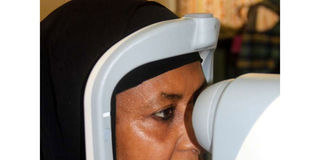Lack of cameras puts diabetes patients at risk of blindness

A woman having her eyes checked. Kenyans with diabetes are at risk of going blind due to lack of eye cameras that would help detect damage to eye blood vessels early enough for intervention. PHOTO|FILE| NATION
Many diabetic patients in Kenya are at risk of losing their sight, as most of those who suffer from a diabetes-linked eye condition do not even know they have a problem, a new study has found.
The study conducted in Kitale, Trans-Nzoia County revealed that 24 per cent of diabetes patients in the region have diabetic retinopathy or damage to the blood vessels in the eye.
Diabetic retinopathy affects blood vessels in the light-sensitive tissue called the retina that lines the back of the eye.
It is the most common cause of vision loss among people with diabetes and the leading cause of visual impairment and blindness among working-age adults.
Prevalence of blindness in diabetic patients increases with age, and prevalence of diabetic retinopathy in eastern Africa ranges from 10 to 47 per cent.
The study done by Operation Eyesight Universal in partnership with the Ministry of Health and the University of Nairobi, revealed that many patients have the condition but are unaware of it.
In Kenya, more than 35 per cent of diabetes patients have diabetic retinopathy. More Kenyans are at risk as the prevalence of diabetes continues to rise.
Prevalence has more than doubled in the last three decades, and is currently estimated at between 3.1 and 4.6 per cent (or between 1.4 and 2.1 million Kenyans).
For the study, researchers enrolled 253 patients (155 women and 98 men), with a median age of 58 years, at the Kitale County Referral Hospital.
The researchers investigated prevalence of diabetic retinopathy as well as prevalence of known risk factors for the condition, including uncontrolled blood pressure, high body mass index and poor blood sugar control.
They found that 79 per cent of patients had uncontrolled blood pressure, 70 per cent had a high body mass index and 33 per cent had poor blood sugar control.
LACK OF EQUIPMENT
While regular eye checks are part of standard treatment for diabetes, 24 per cent of patients had damaged retinas. According to principal investigator Karimuro Jefitha, this could be attributed to lack of specialists and equipment.
“Eye care specialists cannot handle the high number of patients, yet as research shows, diabetic retinopathy is becoming a problem. Diabetes patients risk becoming blind if they don’t seek treatment for this condition on time, and control other risk factors as well. We need more specialists on board to fight the condition,” said Prof Jefitha, who is also the chairman of the Department of Ophthalmology at the University of Nairobi.
In Kenya, there are less than eight retina surgeons, with five based in Nairobi and its environs.
“These specialists don’t have to be in every county. One can take care of 10,000 patients, but they should be distributed so that they can serve patients in the various parts of Kenya,” said Prof Jefitha, adding that Kenya also lacks equipment to aid in early diagnosis.
“We chose Kitale County Referral Hospital because it has an eye camera. Only Kitale, Baringo, Nakuru and the Kenyatta National Referral Hospital have cameras and most are donations. Counties should invest in cameras to serve the huge number of patients,” he said.
The cameras which cost about Sh2 million help detect changes in the early stages of diabetic retinopathy, when there are no symptoms, except difficulties with reading.
While damage from diabetic retinopathy is irreversible, early treatment can significantly reduce the risk of going blind.
Treatment costs between Sh2,000 to Sh120,000 depending on the stage of the condition and how much damage it has done on the retina.
The researchers called for health education and services for diabetes control to prevent diabetic retinopathy, noting that despite the availability of well-established treatment, many diabetes patients in Kenya go blind because they are largely not aware that they have a problem that they need to seek treatment for.
“A timely diagnosis of vision-threatening diabetic retinopathy is necessary to institute sight-saving treatments, and an early diagnosis of diabetes retinopathy is a key starting point,” noted the report.


